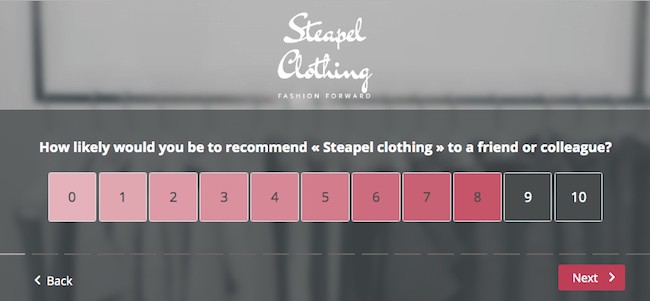When we have a great experience with a brand, we’re generally more inclined to trust them a second time. Positive ratings concerning one of your brand’s products or services are signs of a great customer satisfaction. This satisfaction, if maintained, will lead to customer loyalty and more sales. But how can we effectively measure customer...
When we have a great experience with a brand, we’re generally more inclined to trust them a second time. Positive ratings concerning one of your brand’s products or services are signs of a great customer satisfaction.
This satisfaction, if maintained, will lead to customer loyalty and more sales.
But how can we effectively measure customer satisfaction?
Here are the 4 key satisfaction measures that will quickly become essential to your company’s success!
1- Global satisfaction, the emotional dimension
Question example: Overall, are you satisfied with “Steapel Clothing”?

This question reflects the global opinion of the customer’s satisfaction experience with a product or a service they have used.
The best customer satisfaction predictors are customer experiences that result in attributions of quality.
The perceived quality is often measured in one of three contexts:
- Overall quality
- Perceived reliability
- Aptitude to fulfill clients needs
It’s generally acknowledged that insatisfaction will make a client regret their purchase, whereas, satisfaction is linked to positive ideas such as the feeling that they made the right choice and the comforting that comes with that feeling.
2- Loyalty measure, the emotional and behavioural dimensions
Question example: How likely would you be to recommend « Steapel clothing » to a friend or colleague?
This question is a precise Net Promoter Score (NPS) measure.

Customer loyalty reflects the probability that a client will repurchase a product or service.
Customer satisfaction is a major predictor of repurchase, however, it is strongly influenced by explicit ratings of the products’ performance, quality and value.
Loyalty is often measured using a variety of measures including global satisfaction, repurchase probability and the probability of recommending the brand to a friend or colleague.
A common loyalty measure could be the sum of scores for the following questions :
- Overall, how satisfied are you by our brand?
- How likely are you to continue shopping at our shop?
- How likely are you to recommend our brand to a friend or colleague?
3- Attribute Satisfaction Measures, the affective and cognitive measures
Question example: How satisfied are you by the style of your dress from Steapel clothes?

The affective dimension (I like / I don’t like) is better measured in a context of product attributes or advantages. The customer’s satisfaction is influenced by the perceived quality of the product’s or service’s attributes, and is animated by the customer’s expectations concerning the product or service.
Consumers’ attitudes toward a product develop through information or experiences, whether they are real or perceived.
Once again, it can be useful to measure a consumer’s attitude toward a product or service they have never used but, it is not meaningful to measure their satisfaction about it if not actually used.
The cognitive dimension refers to judgment:
- The product was useful (or not)
- It fit the situation (or didn’t)
- It exceeded the situation’s requirements (or didn’t)
- It was an important part of the overall experience (or wasn’t)
Judgments are often specific to the intended use and context in which the product was purchased, regardless if this use was correct or incorrect.
The affective dimension and satisfaction are very closely linked. The distinction lies in that satisfaction reflects the client’s post experience feelings and represents the affective and emotional dimensions produced by the quality or value of a product.
4- Intention to repurchase measures, behavioral dimension
Question example: Do you intend to come back to Steapel Clothing in the next 30 days?

When a question’s formulation concerns future or hypothetical behavior, consumers often indicate that “purchasing this product would be a good choice” or “I would be happy to repurchase this product”.
Behavioral measures also reflects the consumer’s past experiences with the customer service.
Satisfaction can influence post-purchase / post-experience actions such as word of mouth or messages on social networks.
Repeated post-experience actions reflect the consumer’s strong involvement with the product. This in turn, will lead to increased searching concerning the product and will even change purchase habits or behavior.








